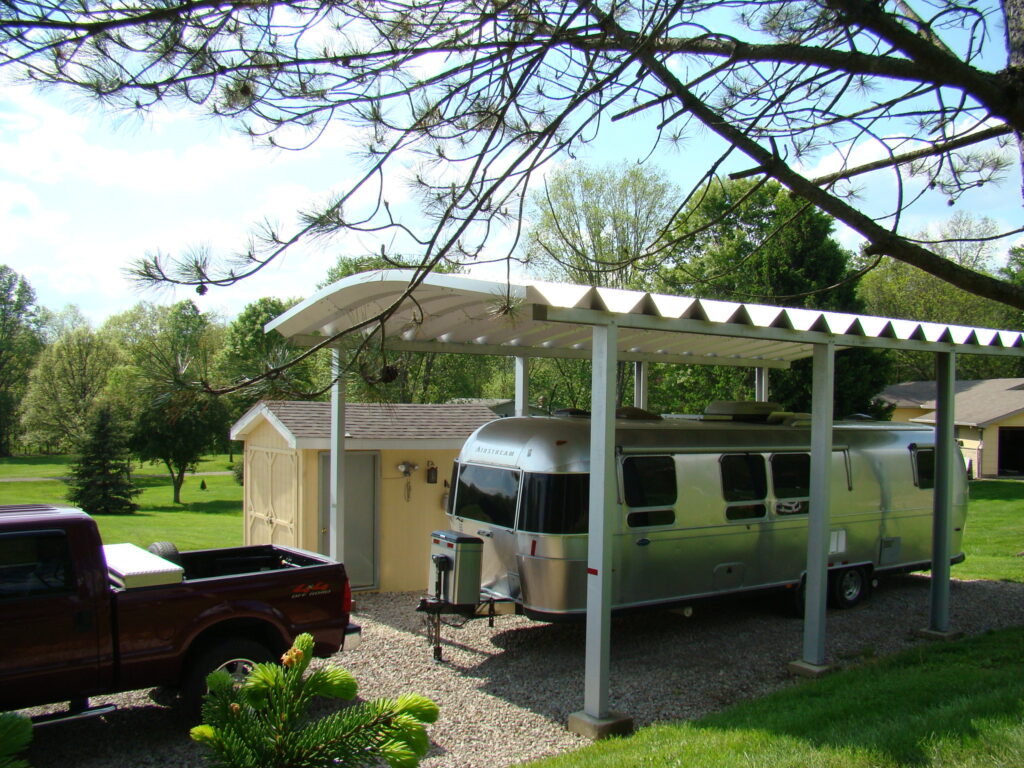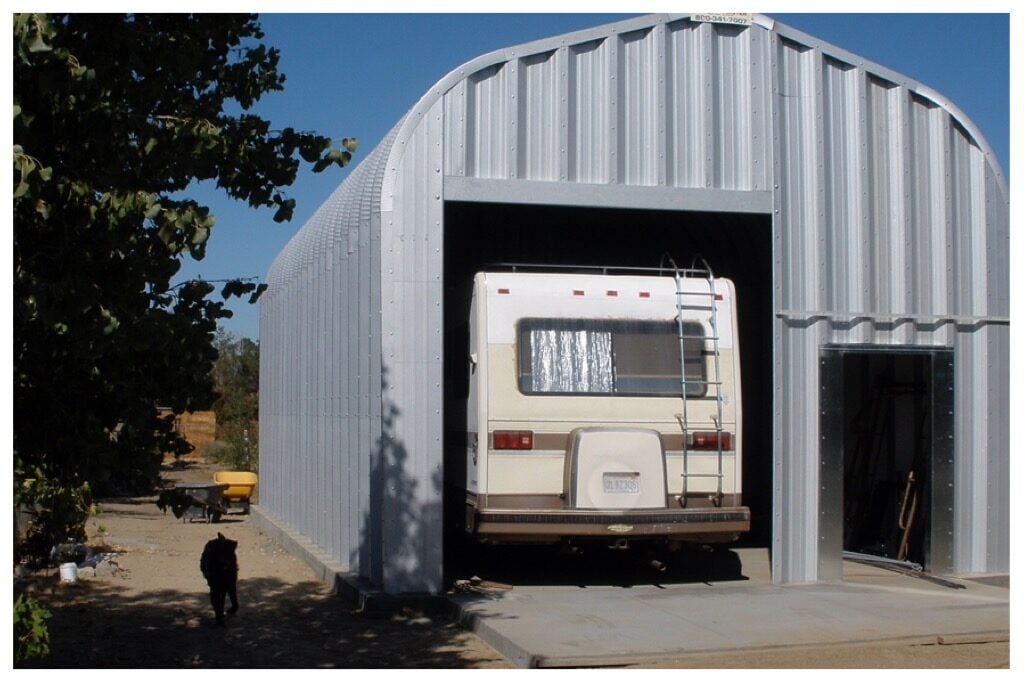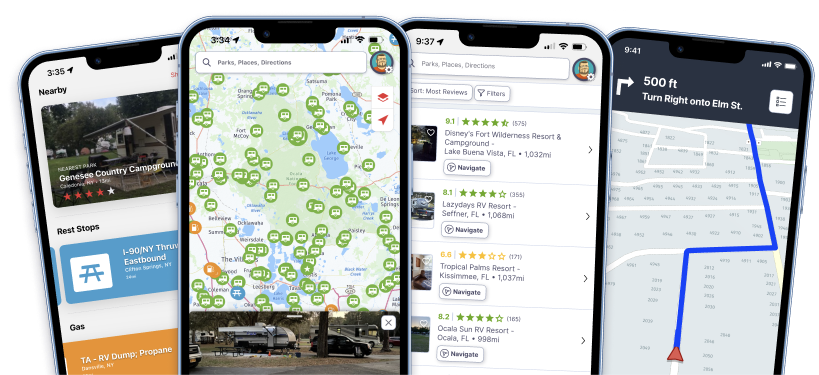What Kind of RV Storage is Best?
For many RVers, the time has come to winterize their RVs and put them in storage for the cold season. Some owners leave their rigs sitting out in the open all winter. But some kind of RV cover is a much better idea. This helps prevent damage from the sun, wind, rain, and other elements. RV covers also ensure your RV is in tip-top shape when camping season rolls around.
There’s no question that covering your motorhome when it’s being stored is the best practice. That said, there is debate about the best way to go about it. Some find it’s most practical to use a motorhome cover of some sort. Ohers feel it’s a much better idea to park under a covered RV storage area.
Wondering which of these options is ideal? Read on to learn the pros and cons of each. Then, you can make the best possible decision for you and your rig.
Choosing The Best RV Cover for You
Let’s start by discussing RV and motorhome covers. There is an enormous number of choices. But when it comes down to it, they are all essentially the same thing. These covers are made using weather-proof material. They come in a variety of shapes and sizes, so you can find one that fits your RV correctly.
The pros of motorhome covers
There are many reasons to choose a motorhome cover when storing your RV. These include the following:
Cost-effective
The first and most compelling argument in favor of motorhome covers is the fact that they can be had for so little money. A quality cover can cost as little as $200. You can have protection for an entire season (or longer) for a fraction of the cost of building a shelter or renting covered storage space.
Keep the RV on your land
If you aren’t willing or able to build a whole shelter for your RV but want to store the RV on your own land, a cover is the best way to go. This gives your rig protection from the outside world while still allowing you to park it right next to your home.
Easy to put away in the summer
Finally, we really like that a cover is so easy to put away and store for the summer months. Unlike a shelter on your land—which will always be there—a cover will stay out of the way until you really need it again.

RV cover – Photo via Amazon
The cons of motorhome covers
Wondering about the drawbacks of using a motorhome cover? There are a couple of important ones that all RV owners should know about before picking this storage option:
Difficult to put on
The number one complaint about RV covers is the fact that they are so hard to put on. It’s nearly impossible for a single person to put the cover on by themselves, and depending on the cover, the task can be challenging even with a couple of people working together.
Won’t protect against everything
Another big drawback is the fact that a cover won’t offer protection from everything. Hail can still damage an RV wearing a cover, and snow can still accumulate and dent or break the roof.
Additionally, water can occasionally make its way through these covers when they are damaged or low quality, leading to mold and other problems related to trapped moisture, so you will need to keep an eye on that.
Covered RV storage
So what about covered storage? Why would somebody choose covered RV storage over a motorhome cover, or vice versa? As you might imagine, this form of storage has its own pros and cons that should be taken into consideration when making your choice.
The pros of covered RV storage
There are a few key benefits of deciding to store your RV under a carport or in its own garage. Let’s touch on those so you have an idea of what to expect:
Better weather protection
The biggest benefit of choosing covered storage is the amount of protection this type of storage provides. Not only will your RV be protected from UV rays and huge rainstorms, but you can also say goodbye to the task of shoveling snow off the roof of your rig. On top of that, hail is no match for a covered storage space.
May be climate-controlled
If you’re willing to seek it out and pay for it, it is possible to find climate-controlled RV storage facilities. Of course, you could also build one yourself. Either way, this would remove the need to fully winterize your rig, making it easy to pull back out and use again as soon as the first signs of spring roll around.
Easy to use
The final major benefit to covered RV storage is the ease of use. While putting a cover on your RV is a huge chore that many people dread, using a covered storage unit is as easy as pulling in and putting the motorhome in park.

Is covered RV storage worth the money? Photo via SteelMaster RV Carport (Flickr Creative Commons)
The cons of covered RV storage
Of course, those pros are met with a couple of cons that should also be thought about before any decision is made. These are as follows:
More expensive
The first and most obvious reason people don’t choose covered storage is the cost. Whether you build your own shed or rent a covered storage space, you will be paying a lot more than you would for a spot out in the open.
Might require offsite storage
Some people don’t have the land or skills to build a shed on their own land. In these cases, having covered storage will mean storing your RV away from home. Some people are uncomfortable with this notion.
Conclusion: Covered RV Storage Wins!
If we had to choose one method, we would prefer covered RV storage over the cover, just because it’s so much easier in so many ways. That said, both choices are perfectly valid and help you reach the end goal of keeping your RV protected from the elements.
That said, it is important to keep in mind that no matter which option you pick, you should still check on your home-on-wheels from time to time. Neither a cover nor covered storage will protect your rig from mice and other pests, and the generator should be run about once a month, even when the RV isn’t in use.
Additionally, you will likely want to ensure the batteries aren’t being drained, and generally have a look around to be sure your RV is safe and secure.
Another option is to rent out your RV, so you do not even need to worry about putting your RV in storage. Learn more about the benefits of renting out your RV here.
Keep track of all your RV maintenance with an online tool such as RV LIFE Maintenance. Not only can you keep all your maintenance records and documents in one place, you’ll receive timely reminders via email when maintenance is due and potentially avoid a costly repair or serious accident.


Newbie question here!!
How many people whine about their 45 foot, 26 ton coach only getting 7MPG? My guess is- Not many.
so-
Why then would someone spend $200,00++++ for a coach and then leave it out in the weather all winter?
Some additional items that were not listed but are definally added benefits of enclosed storage:
– Protection from animals (such as mice & rats) and these little fellas can do a varity of damage to your wires and insultaion over several months.
– Protection from theives, vandels, and the homeless. Having broken windows or someone living in your coach all winter long can also do a varity of damage that may cost more than putting it in storage.
– Having your coach in a storage unit also gives you time to do maintance tasks over the winter. You can perform upgrades, seal the roof, and other issues while the snow is blowing outside.
Even a full building enclosure can still have a vermin issue. Ever had a mouse in your home?? In addition to obvious mice/rat damage, squirrels….tasty bushy tailed rats, I tell you…..are a real damage threat. In addition to under hood electrical wiring damage, squirrels for some reason like chewing on flexible rubber fuel lines. Chewed through fuel line on an Econoline 350 under urban carport, and neighbor’s $80,000 Toyota SUV costing $300+ in repairs…..and creating a possible fire issue were it not detected in time. The vermin can be controlled with the mice/rat bait boxes. Used them successfully around urban and rural food and medical/pharmaceutical manufacturing plants. Now use them around all our rural property…..and even urban….. structures/enclosures. Completely stops the problem. A little Ruger 10/22 is a fun and tasty way to control rural squirrels, also. I even set out bait boxes behind both a front and rear tire at every campground. Out of site and eliminates the vermin issue in the coach. They are safe as domestic animals, including pesky crumb crunchers, can’t access the bait.
Also a pro for having built cover is that you can keep your RV under it when between camping throughout the summer months when the sun can do as much damage as rain.
Why would I spend thousands for my rv, and then rent it to some clown to destroy? And I have no problems putting on, and taking off the cover by myself.
That’s great to have those options whether you have a motorhome or travel trailer, fifth wheeler, toy hauler or even a truck camper. But for many of us there is no option, as location for rv storage is a major factor. Such as whether or not stored at home or at a storage facility and physical limitations. Some can no longer climb ladders nor do live in areas where there are covered storage facilities or have the ability to store on property.
If one can’ climb ladders to install a cover for a long period, a case of beer and a few brats will buy a lot of young energy and camaraderie. There has to be some young guys around that would kindly help for a fun cookout. That why I keep the young guys engaged around our rural acreages…..and someone needs to carry on once I’m gone. Reality is we are all just tourists passing through.
My experience with RV covers is as follows: the cover wears on the edge of the roof at the corners where the roof meets the sides. Also every sharp object on your RV wears or rips the cover (roof projections like antennas, the frame to the steps and other somewhat sharp corners. The corners don’t have to be very sharp to cut or wear through the fabric when a breeze is blowing the cover all winter long.) It was inexpensive, but on the other hand because of those issues and it is a pain to use, it now sits in a box.
Paul, have you considered edge protection for those pointy and sharp projections? Pool noodles, foam pipe insulation, et el can be applied prior to installing the cover to avoid most of those issues. Tape, bungee straps, rope, et el can hold the protective strips in place. Worked for me before I built an enclosed metal building/shop for my coach. Just an old guy’s experience. YMMV.
The wear problem can easily fix by wrapping them with a shop towel and tape, that fix my problem and it does protect your roof from ice in the late fall.
i tryed a cover for our 34 ft DP Itasca, due to TV antennea and different things on the roof.i couldnt get it to work. still havnt found a better one,might remove the antenneas anyway.. we dont watch TV unless its DVDs.
For me indoor storage would result in rental and appointments for drop off and pick up in a location that would likely be several mile from home. I don’t have a walkable roof so I fold my cover on the ground after removal with the top of the cover facing up just as it would on the camper, then fold the walls over the the top. Once the sides are placed on top of the roof cover I fold the back of the cover half way up to the middle of the cover, then the front of the cover half way up. I repeat the moving the front and back half way up until the width is where I want it. Next I fold the sides up until it will fit in the storage bag. When it’s time to use the cover I carry it up on a ladder, placing it in the middle of the camper. With one person on each side I just roll it out on top, then pull the sides down. My current cover is in it’s third winter and still looks like new; I’m hoping to get 5 years out of the cover or win the lottery and build a $40,000 steel building.
Don’t forget that the wind can blow on a covered unit and the cover will chafe the paint, to the point you may have to have some repainting done!
The best solution here, in my opinion ,is a canvas covered tubing framework that you can drive your motorhome into , like a building, that is cost effective!
Stored mine in one for years, and when I was done ,easily sold it to a local fellow, and he erected it on his own land!👍👍👍
Not differentiated in the article is the big cost/benefit step between an open side/roof only cover and a fully enclosed building. Offers additional security, more storage for more than just the coach, better aesthetics, greater property value at sale time. For the open side/roof option, added protection to sides can be added very inexpensively using retired road sign tarps. Yeah, they aren’t paste applied strips of paper any longer. They are heavy weight plastic tarp material with sewn “sleeve loops” the length of the top and bottom. Pipes are inserted through the loop sleeves for hanging at top and tightening at the bottom. Typical sizes are 48′ L x 14-1/2′ W costing around $45 in the Mid-west. Adjust height needed by rolling the pipe/s. Gaps in the pipes allow the tarp to be “wrapped” around the corner post to form an end cover/door. Stop to watch a sign being hung along the road sometime, interesting and idea generating. I’ve used the tarp sides on many roof pavilions at rural acreages for years. Another benefit, the tarps can be installed so they can be rolled up in good weather allowing the structure to function as a large pavilion….ala a vertical RV awning……great for large gatherings, shaded cooler working area.
I have a Class C Coachmen Motor home. I bought it in January 2021 and have used it for numerous trips. I have put about 10,000 miles on it and travelled to about 10-15 states. I contracted to put it in Conditioned storage about 18 miles from my Condo. I had had no difficulty in arranging to pick it up or return it. The facility does request 24 hour notice but I have also given as little as 1/2 hour notice. I clean it before returning, so it is ready to go on short notice. It has shown no ill effects of the travel so far. The storage isn’t cheap but my investment has been very well taken care of. I plan to have this rig for a long time and enjoy the fact that it looks brand new each time I pick it up.